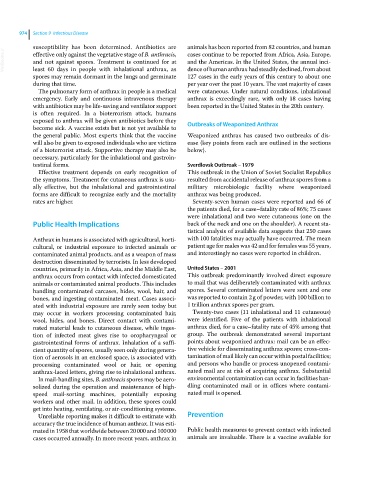Page 1036 - Clinical Small Animal Internal Medicine
P. 1036
974 Section 9 Infectious Disease
susceptibility has been determined. Antibiotics are animals has been reported from 82 countries, and human
VetBooks.ir effective only against the vegetative stage of B. anthracis, cases continue to be reported from Africa, Asia, Europe,
and the Americas. In the United States, the annual inci-
and not against spores. Treatment is continued for at
least 60 days in people with inhalational anthrax, as
127 cases in the early years of this century to about one
spores may remain dormant in the lungs and germinate dence of human anthrax had steadily declined, from about
during that time. per year over the past 10 years. The vast majority of cases
The pulmonary form of anthrax in people is a medical were cutaneous. Under natural conditions, inhalational
emergency. Early and continuous intravenous therapy anthrax is exceedingly rare, with only 18 cases having
with antibiotics may be life‐saving and ventilator support been reported in the United States in the 20th century.
is often required. In a bioterrorism attack, humans
exposed to anthrax will be given antibiotics before they Outbreaks of Weaponized Anthrax
become sick. A vaccine exists but is not yet available to
the general public. Most experts think that the vaccine Weaponized anthrax has caused two outbreaks of dis-
will also be given to exposed individuals who are victims ease (key points from each are outlined in the sections
of a bioterrorist attack. Supportive therapy may also be below).
necessary, particularly for the inhalational and gastroin-
testinal forms. Sverdlovsk Outbreak – 1979
Effective treatment depends on early recognition of This outbreak in the Union of Soviet Socialist Republics
the symptoms. Treatment for cutaneous anthrax is usu- resulted from accidental release of anthrax spores from a
ally effective, but the inhalational and gastrointestinal military microbiologic facility where weaponized
forms are difficult to recognize early and the mortality anthrax was being produced.
rates are higher. Seventy‐seven human cases were reported and 66 of
the patients died, for a case–fatality rate of 86%; 75 cases
were inhalational and two were cutaneous (one on the
Public Health Implications back of the neck and one on the shoulder). A recent sta-
tistical analysis of available data suggests that 250 cases
Anthrax in humans is associated with agricultural, horti- with 100 fatalities may actually have occurred. The mean
cultural, or industrial exposure to infected animals or patient age for males was 42 and for females was 55 years,
contaminated animal products, and as a weapon of mass and interestingly no cases were reported in children.
destruction disseminated by terrorists. In less developed
countries, primarily in Africa, Asia, and the Middle East, United States – 2001
anthrax occurs from contact with infected domesticated This outbreak predominantly involved direct exposure
animals or contaminated animal products. This includes to mail that was deliberately contaminated with anthrax
handling contaminated carcases, hides, wool, hair, and spores. Several contaminated letters were sent and one
bones, and ingesting contaminated meat. Cases associ- was reported to contain 2 g of powder, with 100 billion to
ated with industrial exposure are rarely seen today but 1 trillion anthrax spores per gram.
may occur in workers processing contaminated hair, Twenty‐two cases (11 inhalational and 11 cutaneous)
wool, hides, and bones. Direct contact with contami- were identified. Five of the patients with inhalational
nated material leads to cutaneous disease, while inges- anthrax died, for a case–fatality rate of 45% among that
tion of infected meat gives rise to oropharyngeal or group. The outbreak demonstrated several important
gastrointestinal forms of anthrax. Inhalation of a suffi- points about weaponized anthrax: mail can be an effec-
cient quantity of spores, usually seen only during genera- tive vehicle for disseminating anthrax spores; cross‐con-
tion of aerosols in an enclosed space, is associated with tamination of mail likely can occur within postal facilities;
processing contaminated wool or hair, or opening and persons who handle or process unopened contami-
anthrax‐laced letters, giving rise to inhalational anthrax. nated mail are at risk of acquiring anthrax. Substantial
In mail‐handling sites, B. anthracis spores may be aero- environmental contamination can occur in facilities han-
solized during the operation and maintenance of high‐ dling contaminated mail or in offices where contami-
speed mail‐sorting machines, potentially exposing nated mail is opened.
workers and other mail. In addition, these spores could
get into heating, ventilating, or air‐conditioning systems.
Unreliable reporting makes it difficult to estimate with Prevention
accuracy the true incidence of human anthrax. It was esti-
mated in 1958 that worldwide between 20 000 and 100 000 Public health measures to prevent contact with infected
cases occurred annually. In more recent years, anthrax in animals are invaluable. There is a vaccine available for

